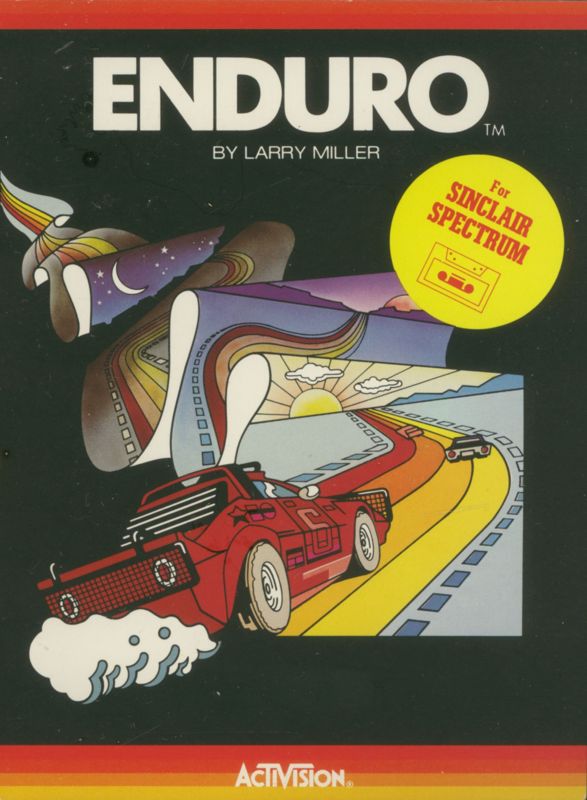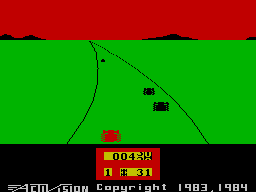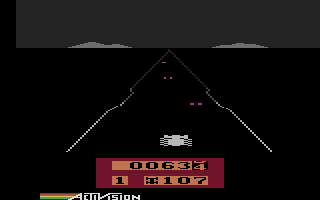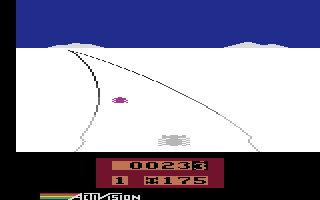Retro Replay Review
Gameplay
Enduro delivers a straightforward yet addictive racing challenge that tests your reflexes and endurance over an ever-changing course. Much like the classic Pole Position, you must weave through traffic at increasing speeds, but Enduro adds a unique twist: each day of the race requires you to overtake a set number of cars under varying conditions. Succeed, and you advance; fail, and your run ends. This simple “pass-or-fail” mechanic fuels the game’s addictive loop, as each successful day only hints at tougher obstacles to come.
(HEY YOU!! We hope you enjoy! We try not to run ads. So basically, this is a very expensive hobby running this site. Please consider joining us for updates, forums, and more. Network w/ us to make some cash or friends while retro gaming, and you can win some free retro games for posting. Okay, carry on 👍)
The game’s day-to-day progression introduces dynamic weather and lighting changes that keep the core loop fresh. Early mornings give way to bright afternoons, followed by night drives where visibility is limited. Seasonal effects such as snow, ice patches, and fog appear sporadically, forcing you to adapt on the fly. As days pass, opposing drivers become noticeably faster and more aggressive, raising the stakes and prompting you to refine your timing and spatial judgment.
Controls are intuitive: a simple left-right joystick motion steers your car, while a push-forward accelerates. This minimalistic control scheme belies the depth of mastery required. Learning the subtle nuances of momentum—when to brake and how to slip past tight clusters of cars—becomes critical as the speed ramps up. For players seeking a pure, skill-based racing challenge, Enduro’s rising difficulty curve ensures every new attempt feels rewarding.
Graphics
Graphically, Enduro may appear rudimentary by today’s standards, but it’s a testament to the Atari 2600’s capabilities. The game renders a three-lane track with simple sprites for your car and the traffic you must pass. While the horizon is flat and the roadside scenery minimalist, the color shifts during day, night, and seasonal effects are surprisingly effective at conveying different environments.
Lighting transitions are one of Enduro’s standout graphical features. Bright daylight is represented by a vibrant blue sky, which gradually darkens during dusk. Come nightfall, the screen turns almost entirely black, punctuated by the headlights of cars—both yours and those you need to overtake. These visual cues not only enhance immersion but also directly impact gameplay, as lower visibility demands greater attention and precision.
The occasional appearance of fog, snowflakes, or icy patches adds visual flair and gameplay challenge. While these elements are simple pixel effects—white specks for snow, slowed-down scrolling for ice—they serve their purpose by breaking up the monotony of straight racing lanes. The odometer at the bottom of the screen ticks steadily as you progress, providing a clear visual measure of success and fueling the drive to beat your personal best.
Story
Enduro doesn’t offer a narrative in the traditional sense—there’s no protagonist backstory, no branching dialogues, and no cutscenes. Instead, the game’s “story” unfolds through your performance and endurance. Each in-game day you conquer is a chapter in a larger tale of perseverance against increasingly harsh conditions and faster competition.
This race-of-endurance concept taps into the universal appeal of overcoming obstacles over time. As you transition from dawn to dusk, and through seasonal challenges like snow and ice, you become the hero of your own minimalist rally saga. The absence of a scripted plot allows you to fill in the blanks with your imagination, transforming each run into a personal journey of skill and resilience.
For many players, the evolving environment and escalating difficulty become the narrative engine driving their experience. You don’t follow a preset storyline—you create it by deciding how long you can last and how far you can push yourself. In that sense, Enduro’s story is as much about player agency and self-set goals as it is about racing through pixelated landscapes.
Overall Experience
Enduro shines as a pure, unadulterated test of racing reflexes and endurance. Its sparse presentation and incremental challenge curve may feel dated compared to modern racers, but they also strip away distractions, leaving only the thrill of outmaneuvering opponents under shifting conditions. This laser focus on core gameplay makes each victory satisfying and each failure a clear lesson for your next attempt.
The game’s replay value is exceptionally high. With no finite campaign to complete, every session is about beating your previous day count or distance on the odometer. This “just one more try” ethos keeps you coming back, striving to master the slippery ice patches or perfect your strategy for the pitch-black nights.
For potential buyers intrigued by retro gaming or those seeking a streamlined racing challenge, Enduro offers an engaging experience that stands the test of time. Its blend of simplicity, dynamic conditions, and relentless difficulty curve makes it a must-play title for Atari enthusiasts and anyone curious about the roots of arcade-style racing. Strap in, start your engine, and see how far you can go.
 Retro Replay Retro Replay gaming reviews, news, emulation, geek stuff and more!
Retro Replay Retro Replay gaming reviews, news, emulation, geek stuff and more!









Reviews
There are no reviews yet.